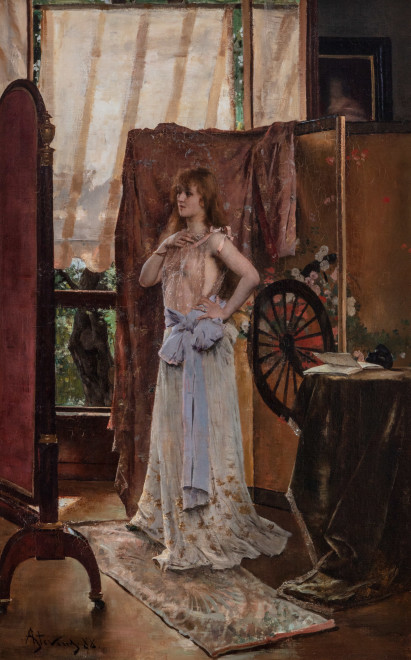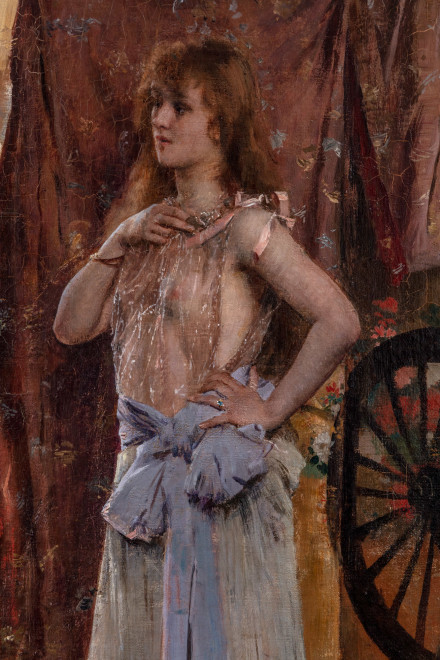Une comédienne offers us some insight into Alfred Stevens, an avant-garde artist for his time, and whose female types, such as our actress, were as modern as Manet’s Victorine Meurant, Renoir’s Jeanne Samary and Monet’s Camille.
Provenance
R. Langbank
J. Speth, Anvers
Sale: Palais des Beaux-Arts, Brussels, May 28, 1974
Galerie J. P. Meulemeester, Brussels, by 1975
Charles de Pauw, Brussels
Galerie de Jonckheere, Paris
Sale: Christie's, New York, February 18, 1993, lot 110
Acquired at the above sale by the present owner
Exhibited
Charleroi, Palais des Beaux-Arts, Rétrospective Alfred Stevens, January 11-February 16, 1975, no. 50
Paris, Biennale des Antiquaires
Literature
G. van Zype, Les Frères Stevens, Brussels, 1936, no. 202
Christiane Lefebvre, Alfred Stevens, 1823-1906, Paris, 2006, p. 122, illustrated p. 113, no. 29
Catalogue note
Painted in 1888, Une comédienne shows a young actress rehearsing for a theatrical role in front of a mirror. It coincides with Stevens’ great portraits of Sarah Bernhardt from the 1880s and in fact, Stevens used a similar composition six years later in a painting of Sarah preparing for her role in the play, Izeyl. The subject of Une comédienne may also have been inspired by Stevens’ contemporary, Henri Gervex. In 1886, Gervex’s entry to the Paris Salon featured a standing nude wearing a black mask posed in front of a full-length mirror, a scandalous painting that caused an uproar when it was exhibited. However, the differences in each painting are stark and reveal Steven’s more subtle approach to painting the sensuality of the female form.
Set in a tastefully appointed boudoir, which features typical Stevens’ props such as the Oriental screen draped with a silk kimono and a table covered in heavy velvet fabric, Steven’s actress practices her lines, her script and black mask at the ready nearby. An awning in yellow stripes diffuses soft light through an open window where the silhouette of a tree is reflected in the sunlit cloth. The sheer gold-threaded camisole of the model, tied at the neck with a pink satin ribbon, hints at her sensuality. Her long skirt falls in a cascade of undulating folds and movement, and the pale lavender sash tied in a bow at her waist speaks of Steven’s distinctive use of color; his choice of costume for his models always represented the latest sartorial trends. Stevens never depicted a nude in his entire career. Even his model bathing in the tub in the 1867 The Bath (Musée d’Orsay, Paris) is wearing her undergarments. Contemporary commentators noted that Stevens could convey a strongly sensuous mood with very little flesh exposed (W. Coles, Alfred Stevens, exh. cat., Ann Arbor, 1977, p. 39).
Une comédienne offers us some insight into Alfred Stevens, an avant-garde artist for his time, and whose female types, such as our actress, were as modern as Manet’s Victorine Meurant, Renoir’s Jeanne Samary and Monet’s Camille.






